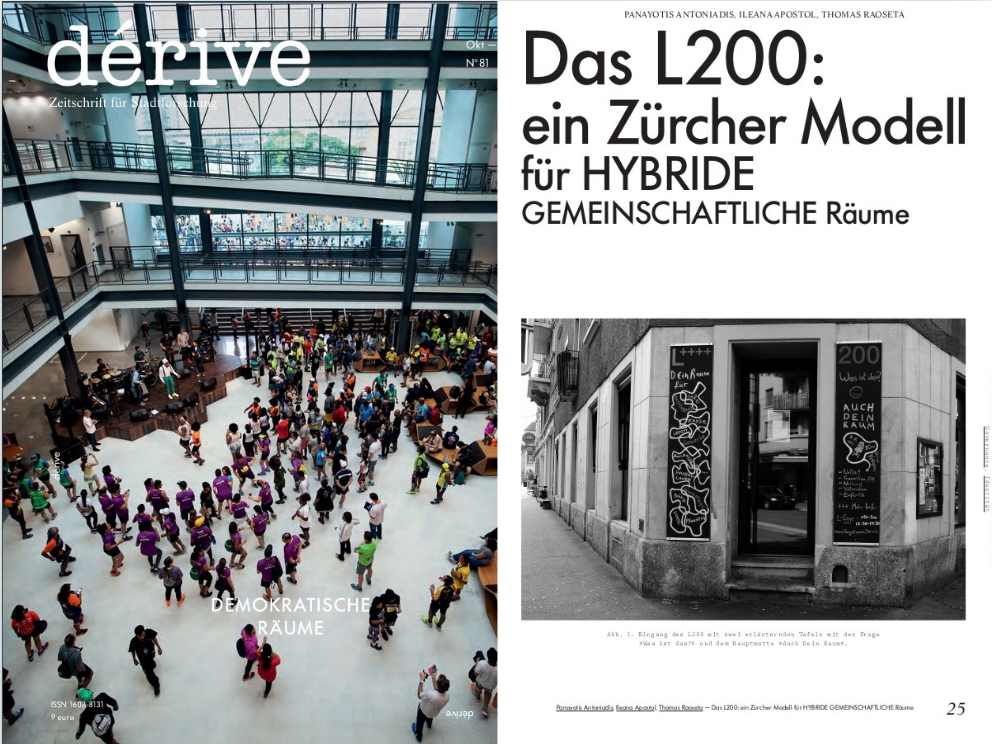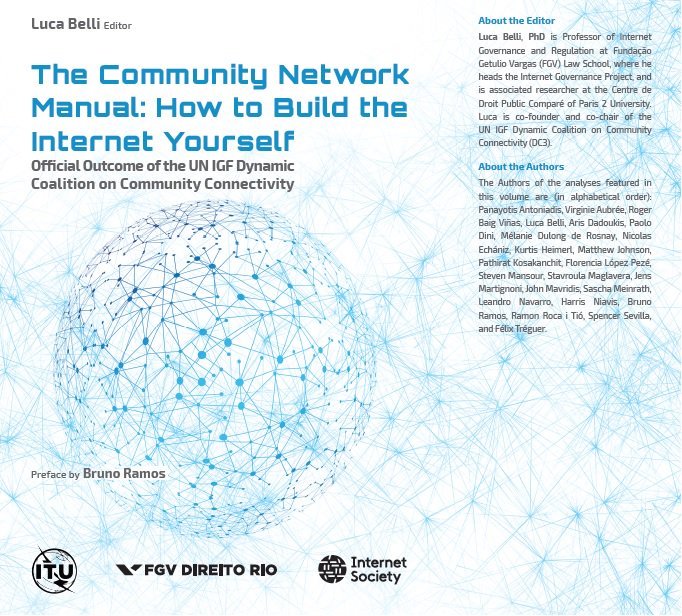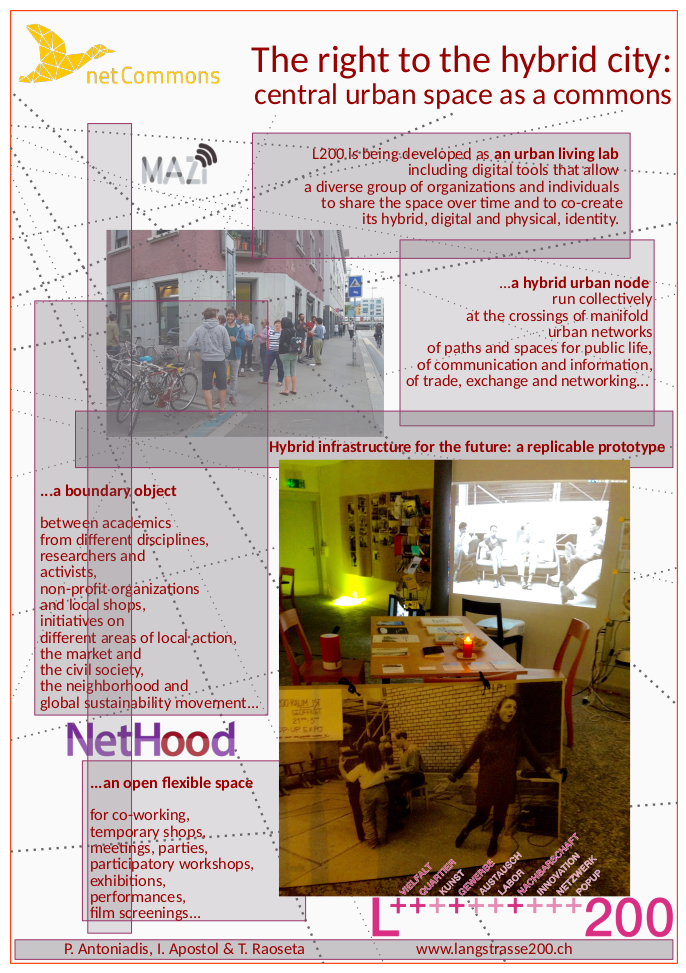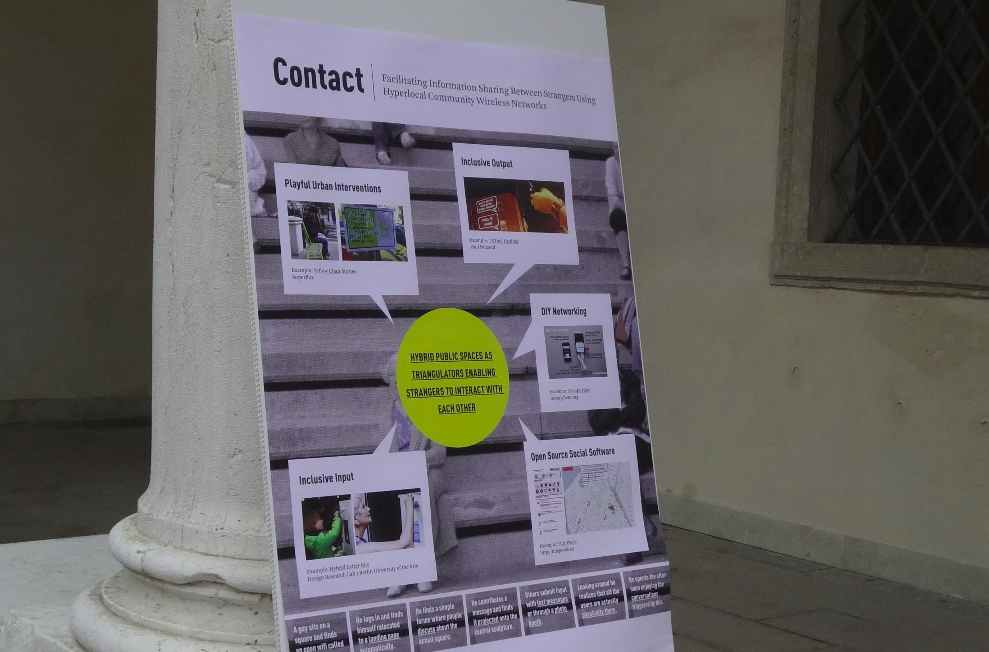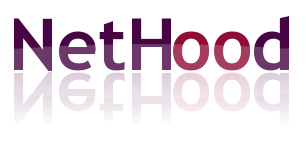
|
about
projects
papers
events
contact
|
P2P Learning
P. Antoniadis and A. Pantazis
Handbook of Peer Production. Routledge, 2021.
[pdf]
In this chapter we identify a wide variety of learning projects, platforms, tools, and methodologies which could be characterized as “peer-to-peer” and present their main characteristics along three core dimensions (curriculum selection, learning process, and knowledge abstraction). We then discuss how p2p learning processes can be encouraged, facilitated, and supported by digital and physical infrastructures, keeping a critical outlook on the often hidden power asymmetries that are always present at the infrastructure level. We pay particular attention to the case of small intentional groups of adult learners, and to four exemplary case studies -- two digital platforms and two physical spaces -- with similarities and differences, which help us to deconstruct and critically analyse the different dimensions of p2p learning identified.
Central urban space as a hybrid common infrastructure
I. Apostol and P. Antoniadis
In Journal of Peer Production, Issue #14, 2020 [publisher] [pdf]
In this paper we document and reflect on an ongoing co-design process of a new urban space, by the name L200, located in a very central and precious location in Zurich. L200 has the characteristics of an urban node at the confluence of many networks, a hub like railway stations provide these days but at a different spatial scale, acting as a much needed infrastructure for various commoning activities, among others. L200 is designed as a hybrid space, hosting a DIY digital platform, which is being co-created as a commons itself through a long-term participatory process and provides a building block for an alternative, bottom-up, vision to the “smart city”. In terms of participatory design, we experiment with, and advocate for, a structured laissez-faire methodology that frames both the physical and digital space as interconnected common infrastructures that the members of the association are free to use “as if it was their own” for limited periods of time. The paper lays out the overall L200 project in its full complexity through the dual role assumed by the authors, as researchers and activists, highlighting specific decisions, actions, and methodologies that contribute to the on-going research on infrastructuring the commons.
A related (shorter) article in German with Thomas Raoseta, in Derive (2020)
Telecommunications Reclaimed: A hands-on guide to networking communities
P. Antoniadis, I. Apostol, V. Aubrée, A. Burns, M. Dulong de Rosnay, M. Michalis, J. Neumann, R. Roca, F. Tréguer
ISOC, 2019
Available at: https://netcommons.eu/telecommunications-reclaimed
Hardcopy: Amazon print on demand
This guide on how to build a community network, a shared local telecommunications infrastructure managed as a commons, was written collectively by a group of pioneers of community networks in Europe, activists and researchers.Meant for a wide audience, it is full of anecdotes as well as legal, technical, governance, economic and policy recommendations based on the three-year-long European research project netCommons. Its goal is to take the reader through a set of actions aimed at setting up and fostering the growth of community networks, and to provide a mix of practical knowledge and explanations illustrated by hands-on experiences and real-life stories.Starting with presentations of established community networks, and an introduction to the importance and the role of community networks, it provides step-by-step guidelines and concrete information on the resources needed to start a community network, get it running, and keep it sustainable in the long term. From technical options to economic models, governance choices, legal requirements, and the various skills needed to be involved, this lively resource proposes ways to engage with a local community at every stage of a community network.
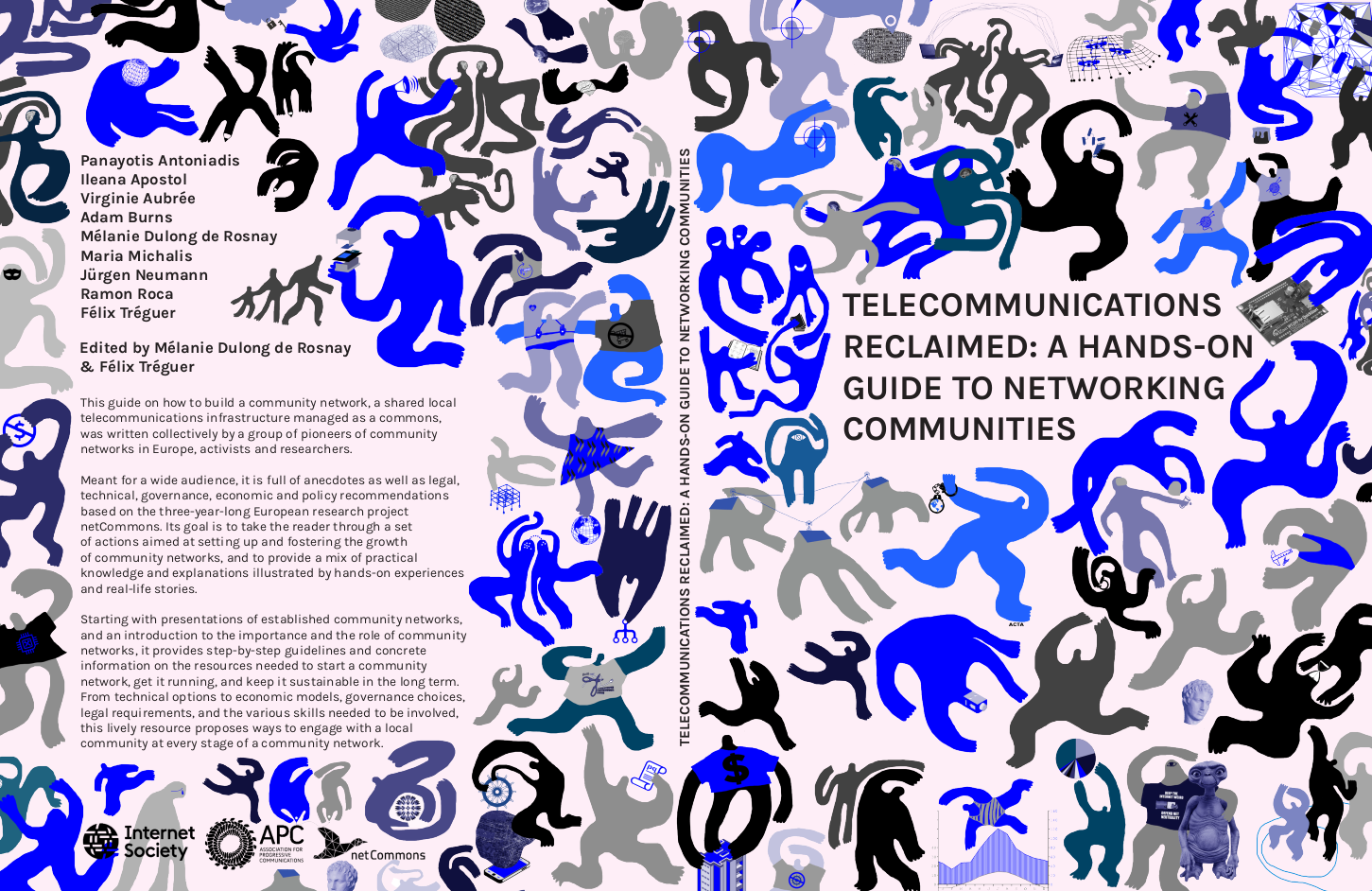
The Organic Internet as a Resilient Practice
P. Antoniadis
In Trogal, K., Bauman, I., Lawrence, R., and Petrescu, D. (eds.), Architecture and Resilience: Interdisciplinary Dialogues [publisher] [pdf]
The idea that digital and physical space are increasingly interconnected, and thatarchitecture and urban design should be conceptualised beyond buildings, streets and so on, is rather old and well understood. What is less clear is the fact that digital space is socially and politically ‘produced’ in similarly complex ways to thephysical. It is thus subject to power structures, manipulation tactics, fundamental rights, borders and constraints, despite its perceived ‘infiniteness’.

Two book chapters:
1) What Could Blockchain do for Community Networks by P. Antoniadis and J. Martignoni [pdf]
2) Complementary Networks Meet Complementary Currencies: Guifi.net Meets Sardex.net by P. Antoniadis, J. Martignoni, L. Navarro, and P. Dini [pdf]
In Belli, L. (editor), The community network manual: how to build the Internet yourself, FGV Direito Rio, 2018.
The right to the hybrid city: Central space as a commons
I. Apostol, P. Antoniadis, and T. Raoseta
Poster paper for the Swiss Inter- Transdisciplinarity Day 2018, "Inter- and Transdisciplarity in a Digital World" [poster]
Fifty years after Henri Lefebvre published on 'the right to the city', we propose to discuss the concept under the current digital and physical spatial condition. Today urban spaces shall be conceived as hybrid, physical and digital, due to the advance of ICTs and their impact on almost every aspect of social life; a key question arises, how the different rights to the hybrid urban space can be claimed by citizens. NetHood, a transdisciplinary association undertaking research and learning within the hybrid spatial conditions, focuses on the right to centrality and to difference, for which the city of Zurich brings particular challenges and opportunities. In context a promising project was initiated recently: the co-creation of a neighbourhood space in a key location of the city center, by the name L200, conceived as a hybrid urban node run collectively.
The Organic Internet: Building Communications Networks from the Grassroots
P. Antoniadis
In Co-Designing Economies in Transition, New York, Palgrave Macmillan, 2018. [publisher] [pdf]
The popular Internet platforms that mediate today our everyday communications become more and more efficient in managing vast amounts of information, rendering their users more and more addicted and dependent on them. Alternative, more organic, options like community networks do exist and they can empower citizens to build their own local networks from the bottom-up. This chapter explores such technological options together with the adoption of a more healthy Internet diet in the context of a wider vision of sustainable living in an energy-limited world.
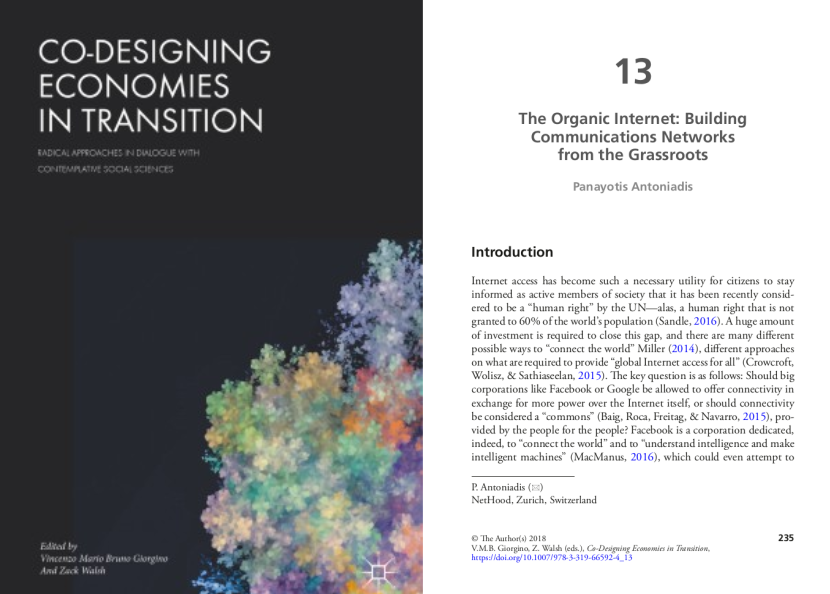
Local networks for local interactions: four reasons why and a way forward
P. Antoniadis
First Monday, December 2016 [publisher]
This paper frames the role of community (wireless) networks, and other forms of grassroots DIY networking models, as complementary to the Internet communication infrastructures hosting local services for facilitating local interactions, as drivers for a more convivial and sustainable life in the city. The paper analyses four key reasons, practical, social, political, and scientific, why such DIY networks should be considered as a viable complementary infrastructure for local communications even when Internet access is available. Through analogies with other relevant domains of local action, namely complementary currencies and cooperative housing, I conclude by addressing the dichotomy between local action and global coordination. I advocate for the co-creation of convivial ICT tools for building local communities, or better hybrid spaces of local cooperation, which are larger in size than the small in “small is beautiful” and smaller, but in many cases more diverse, than recent imaginaries of the “multitude”.
Urbanity and the right to difference
I. Apostol
studies in History and Theory of Architecture, Volume 3/2015 [publisher] [pdf]
After The Urban Revolution (1970), the following book written by Henri Lefebvre and published at Gallimard was The Differentialist Manifesto. He wrote this Manifesto with the conviction that the world of difference is another manner of thinking, acting and living, and later on he elaborated on the right to difference as a condition to provide the right to centrality in the city. To build an understanding of Lefebvre's dialectical thinking requires, nevertheless, explorations of his writings across their continuum. Thus I bridge in this essay the insights of these two crucial works, which form the basis of my argument for affirming differences without exclusion within an ideal of civil urbanity. This theoretical journey was inspired by the ongoing political processes regarding the conception and implementation of collective forms of housing, workspace and living in Zurich, Switzerland. As they hint at the social role of spatial designers as citizen-activists, I suggest further that their civic presence and their role as communication vessels have the potential to revive the relevance of the spatial design professions.
DIY networking as a facilitator for interdisciplinary research on the hybrid city
P. Antoniadis, I. Apostol, M. Gaved, M. Smyth, A. Unteidig
Hybrid City Conference, Athens, September 17-19th 2015. [pdf]
DIY networking is a technology with special characteristics compared to the public Internet, which holds a unique potential for empowering citizens to shape their hybrid urban space toward conviviality and collective awareness. It can also play the role of a “boundary object” for facilitating interdisciplinary interactions and participatory processes between different actors: researchers, engineers, practitioners, artists, designers, local authorities, and activists. This position paper presents a social learning framework, the DIY networking paradigm, that we aim to put in the centre of the hybrid space design process. We first introduce our individual views on the role of design as discussed in the fields of engineering, urban planning, urban interaction design, design research, and community informatics. We then introduce a simple methodology for combining these diverse perspectives into a meaningful interdisciplinary collaboration, through a series of related events with different structure and framing. We conclude with a short summary of a selection of these events, which serves also as an introduction to the CONTACT workshop on facilitating information sharing between strangers, in the context of the Hybrid City III conference.
The right(s) to the hybrid city and the role of DIY networking
P. Antoniadis and I. Apostol
Journal of Community Informatics, special issue on Community Informatics and Urban Planning, vol. 10, 2014. [publisher] [pdf]
We reconsider the concept of "the right to the city", introduced by French philosopher Henri Lefebvre, in the light of the new information space that ICTs create in contemporary urban environments. Such spaces include the use of global online social networks, locative media, e- participation platforms, online neighbourhood communities and so forth. Unlike the physical urban space that it overlays, this new and rapidly emerging virtual space has practically no capacity constraints. However, it is subject to inequalities in terms of access, representation, participation, and ownership. In this research note---an interdisciplinary collaboration between a computer scientist and an urban planner---we wish to study the role of wireless technology, which enables the easy deployment of local networks operating outside the public Internet, and the role of the free and open source social software, which facilitates the easy development of customized local applications, allowing citizens to shape their emerging hybrid space. We suggest that this sort of do-it-yourself (DIY) networking can be realised according to citizens' values, objectives and the particularities of the environment, and could ultimately enable them to compete with large ICT corporations such as Google and Facebook for their "right(s) to the hybrid city". We employ the urban sidewalk metaphor as an application that is subject to hybrid design and can profit significantly from the special characteristics of DIY networks.
CONTACT: Facilitating Information Sharing between Strangers Using Hyper-local Community Wireless Networks
P. Antoniadis, I. Apostol, A. Unteidig, and G. Joost
UrbanIxD Symposium 2014, Venice, Italy [pdf]
This position paper proposes an experimental and interdisciplinary design approach for building hybrid social applications, bringing together knowledge and expertise from computer science, urban planning, sociology, arts and design. Our aim is to provide novel interfaces that stimulate strangers in the city to interact, to get in contact, in a low-threshold way. That is, without sacrificing privacy and without requiring high levels of commitment. We argue that the development of easily customized hybrid social applications designed to run on a local wireless network physically attached to appropriate urban interventions, what we call a CONTACT zone, can be a very effective incentive for citizens to participate in the creation of situations where strangers may informally connect and exchange information of various types.
Do It Yourself Networking: an interdisciplinary perspective
P. Antoniadis, J. Ott, and A. Passarella (eds.)
Dagstuhl reports, 4(1): 125-151, June 2014. [publisher] [pdf]
This report provides a summary of the organization, program, and outcome of the Dagstuhl seminar titled "Do-It-Yourself networking: an interdisciplinary perspective". We first motivate our interest in wireless networks operating outside the public Internet and the selection of the various areas of expertise. Then we describe the process of bringing together a balanced group of representatives from these fields, and the evolution of the seminar over time. An overview of the interactions during the work in groups on specific application areas and explorations of the concept of failure, edited collectively by the members of the different groups, summarizes the main outcomes of the seminar. Finally, we identify some important lessons learned for facilitating interdisciplinary collaborations and conclude with our plans toward building a DIY networking community of researchers and activists.
The Neighbourhood Game: from Behavioural Economics to Urban Planning
P. Antoniadis and I. Apostol
1st International Conference on Internet Science, Brussels, 10-11th April, 2013. [paper, slides]
The rapid advances of information and communication technologies (or ICTs) and the mass online participation have increased the expectations for the long awaited visions of e-participation and e-democracy. However, there are still many challenges that need to be addressed related to privacy, data ownership and control, and various types of digital divides. Perhaps the most fundamental requirement is the need for information exchange between parties that do not necessarily share common interests, education, and cultural backgrounds. To achieve this ambitious objective, ICT could significantly help given that we understand in depth the way it affects behaviour in the evolving hybrid (virtual and physical) space of modern cities. The next step is to empower communities with sophisticated tools to help them build trust, accept diversity, and engage in productive deliberations. In this paper we introduce a research framework connecting two relatively distant until today disciplines, namely behavioural economics and urban planning, through the mediation of computer science. More specifically, we describe a long-term social learning process evolved around a configurable ICT framework, the NetHood Toolkit, which will support a wide variety of hybrid interactions between people in physical proximity. The definition of a specific set of information sharing games with various configuration options can then form the basis for a real life experimentation process with potential benefits both for understanding human behaviour and for reaching important social objectives.
Flânerie between Net and Place: Possibilities for Participation in Planning
I. Apostol, P. Antoniadis, and T. Banerjee
Journal of Planning Education and Research, 33(1):20-33, March 2013. [publisher]
We introduce the practice of flânerie in the physical and virtual space as a method to produce representative images of contemporary social life. We suggest how planning may be instrumental in shaping a public good alternative in this emerging hybrid social space, where the practice of flânerie can stimulate engagement in deliberative planning practices. Finally, we discuss some of the trade-offs and design choices for eliciting information from citizens about their localities in order to understand how future development may lead to qualitative changes in the community life.
Cyberspace Design: A New Challenge for Planners
I. Apostol, P. Antoniadis, and T. Banerjee
ICE Journal of Urban Design and Planning, 166(3): 156-163, September 2012. [publisher]
We propose a conceptual framework for planning and design practice to incorporate self-consciously the hybrid space of the virtual and physical. Cyberspace has now become a commonplace environment for social and public life, and its complex uses are entwined with those of the existential life in the physical environment. Therefore, it is argued, planners must engage in the design of the parallel realities of social and public life in these spaces. This paper proposes to look at them in a rhizome-like spatial formation, and in their future design to apply related planning knowledge on places and communities. Based on observations of online activity, the paper illustrates a method to analyse cyberspace's quality by means of Kevin Lynch's taxonomy of images, and of William H. Whyte's method to evaluate spatial uses. Spatial elements are identified through analogies between the virtual and the physical social environments, in order to derive alternatives for future (hybrid) spatial design.
USB Nets: From Message Ferrying to Leisure
P. Antoniadis, L. Chen, and F. Legendre
Proceedings of ACM ExtremeCom, 2012. [pdf]
Offering a USB flash drive filled with personalized or generic content, with or without direct reciprocation is a low-cost alternative for content sharing, message ferrying and other interesting delay tolerant applications, which we call USB Nets. The success of a USB Net crucially depends on the motivation of a few influential people or a public authority to bootstrap this process and of the rest to play the game. In this position paper we bring forward this underutilized mode of communication and identify the most important building blocks of a USB Net and our under development USB Net setup application. Our long-term objective is to allow non-technical users to configure and bootstrap a wide variety of USB Nets, like the ones we describe in this paper and many others we have not thought of.
Places on the Net
I. Apostol, P. Antoniadis, and T. Banerjee
Cities 3.0, 14th International Conference on Urban Planning and Regional Development in the Information Society, REAL CORP, Sitges, Spain, April 2009. [pdf]
In this paper we aim to build an understanding on how the concept of place is encoded in the design of online communities. Current activities in such communities suggest that users appropriate virtual space through (self)-representation. In general, the investment with meaning of space is likely to define places on top of it. So we are interested to find out whether places emerge in cyberspace. Brief analyses of existent online communities show that the understandings of space and place vary from one community to another, which relates to their capability to connect with the local place-based communities. Searching for a theoretical framework that would explain these observations, we explore first how different constructs of place associate in theory with various views on the nature of space. Second, we are interested to find out how users perceive cyberspace, by questioning whether an analogue to Lynch’s taxonomy of images and the use of cognitive maps are meaningful in this context. We wish to use this information in future design of hybrid online communities, in order to bridge the virtual with the physical space for social activities.
From Face-Block to Facebook or the Other Way Around?
I. Apostol, P. Antoniadis, and T. Banerjee
International workshop on Sustainable City and Creativity: Promoting Creative Urban Initiatives, Naples, September 2008.
[pdf]
Can network technology stimulate communities of propinquity and sustainability? We explore in this study the relation between communication technology, the production of space for public life, and community building in the contemporary city. For that we propose the collaboration of urban planning and computer science, for the design of virtual communities that are deferent to physical space (hybrid). We aim to stimulate creativity, generate common interest and promote physical interactions in the neighborhood with the existing tools used to design web-based online communities. The critical piece that should be in place for the success of such an effort is the participation of community members. In this paper we focus on one of the possible ways to address this challenging problem: creativity within collective action. We explore a new type of collective action enabled through the steadily advancing wireless technology. That is the ability of a community to create a cost-effective user-owned wireless network to support their internal communication needs and offer free access to the Internet. We propose a new type of hybrid community--a wireless neighborhood community--that exploits this technological potential and provides an institutional framework for the community at the neighborhood level. For this we analyze examples of neighborhood collective action that are successful in the physical space, which could guide the design of wireless neighborhood communities.
Community building over Neighborhood Wireless Mesh Networks
P. Antoniadis, B. Le Grand, A. Satsiou, L. Tassiulas, R. Aguiar, J.P. Barraca, and S. Sargento
IEEE Technology and Society. Special issue on Potentials and Limits of Cooperation in Wireless Communications, 2008
[publisher]
[pdf]

